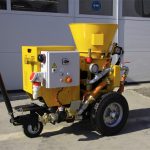Tyrolean rendering is a cement based render containing silicone which gives the render its waterproof properties. It is a finish used on masonry or concrete wall surfaces, suitable in an environment where there water is nearby and/ or high humidity e.g. coastal, suburban and rural environments.
Tyrolean is usually applied using a hand operated or open-hopper spraying machine (Fig.1). The applied Tyrolean render can be made to have the appearance of ‘honeycomb’ shapes by using several strokes from different angles until a finished thickness of 4mm – 6mm is achieved.
Fig.1:

The Tyrolean rendering can be done on a substrate such as a rough wall surface.
Note: The substrate must possess suction capabilities for the Tyrolean finish to achieve the desired effect. The wall surface can also consist of a troweled backing. This is for internal finishes when doing feature walls. Rendering done on external walls should be mixed with at least ten percent of lime. The thickness for this finishes on troweled backings should be at least ten to fifteen millimetres. The Tyrolean machine to use should throw the mortar mixture evenly on the wall surfaces.
Properly curing (drying) and ensuring correct mixes of Tyrolean render are very important. Also, Tyrolean can have coloured cements incorporated to make it more attractive.
When preparing the Tyrolean mortar mix, it should have the appearance of cement slurry i.e. the solid sand and cement can be clearly seen floating around the water within the mixture and if the mixture is left motionless, the solid cement and sand particles will eventually settle towards the bottom of the watery mixture. The machine has wires embedded inside that collect the mortar as they spin and splash it on the wall or ceiling surfaces. First step in applying Tyrolean render os to remove any stone or concrete excess found on the rendered surface. The surface is rimmed to form a fairly smooth surface. Apply the backing/ primary coat evenly with a trowel. Use a wooden float to smooth by swing upright runs. Allow this texture to dry overnight.
Add Tyrolean mixture into the machine and whirl the wires round. As the mortar mix is applied to the wall or ceiling use a towel to remove excess mortar. On feature walls use a timber batten to mark the area to be rendered. After the surfaces are complete, remove the battens. Once the texture is dry additional paint work can be done. Alternatively colored cements can be applied to achieve desired effects. Cure the mortar with water for a week .